Table of Contents
Have you ever wondered about the ancient origins of worship and culture?
How did the Israelites express their devotion to God?
The answer lies in one remarkable structure – the Tabernacle. Step back in time as we take you on a journey through biblical history, exploring the significance of the Tabernacle in ancient Israelite worship and culture.
The Tabernacle holds a deep and enduring place in the hearts of believers, but its true meaning and purpose can often remain shrouded in mystery. Join us as we unveil the secrets of this sacred space, shedding light on its construction, symbolism, and rituals.
Discover the profound theological insights and the historical and cultural context that surround the Tabernacle, providing a deeper understanding of biblical history and theology.
So, are you ready to embark on this enlightening journey? Let’s dive into the ancient world of the Tabernacle and unlock the mysteries that have captivated generations of believers.
The Structure and Design of the Tabernacle
When examining the tabernacle, it is essential to understand its construction, materials used, design elements, and the symbolism incorporated into its structure.
The tabernacle was meticulously crafted to serve as a place of worship and a symbol of the Israelites’ relationship with their God.
To provide an overview of the tabernacle’s construction, let’s delve into the materials used. One of the key materials was acacia wood, known for its durability and resilience.
The wood was carefully constructed into frames, poles, and other structural elements. In addition to acacia wood, precious metals like gold, silver, and bronze played a significant role in the tabernacle’s construction. These metals were used to create intricate details, including decorative overlays and furnishings.
The design of the tabernacle was nothing short of remarkable. Every detail was deliberate and purposeful, with each element carrying symbolic significance.
From the intricate tapestries and curtains to the shape and layout of the various compartments, everything had a deeper meaning. The design of the tabernacle reflected God’s desire for a sacred space where His presence could dwell among His people.
Symbolism abounds within the tabernacle’s design. The veil, for example, served as a barrier between the Holy Place and the Most Holy Place, representing the separation between God and His people and the need for a mediator.
The golden lampstand, with its branches and almond-shaped cups, symbolized the light of God’s wisdom and guidance. The intricately crafted cherubim on the Ark of the Covenant represented the heavenly beings guarding the divine presence.
In the construction of the tabernacle, every detail was carefully considered, resulting in a structure that not only served its practical purpose but also conveyed profound spiritual truths.
By understanding the construction, materials, design, and symbolism of the tabernacle, we gain a deeper appreciation for its significance in Israelite worship and its foreshadowing of future events.
The tabernacle laid the foundation for later temples and the ultimate revelation of God’s presence through Jesus Christ.
Next, let’s explore the key components and artifacts found within the tabernacle, shedding light on their meanings and significance.
Key Components and Artifacts
Within the tabernacle, a sacred space for worship and encounter with the divine, various key components and artifacts held immense significance. These sacred items included the renowned ark of the covenant, the table of showbread, the golden lampstand, the altar of burnt offering, the bronze laver, the incense altar, and the veil of the tabernacle.
The ark of the covenant symbolized the presence of God and contained the two stone tablets of the Ten Commandments. It was considered the most sacred and revered item within the tabernacle.
The table of showbread held twelve loaves of bread made from fine flour, representing the twelve tribes of Israel. It symbolized the provision and sustenance provided by God.
The golden lampstand, also known as the menorah, was a seven-branched lampstand made of pure gold. It symbolized the divine light and presence that illuminated the tabernacle.
The altar of burnt offering was where animal sacrifices were made as acts of worship and atonement. It symbolized the need for repentance and the offering of oneself to God.
The bronze laver served as a basin for the priests to cleanse themselves before entering the tabernacle. It symbolized purification and spiritual cleansing.
The incense altar was used for burning fragrant incense, representing the prayers of the people ascending to God. It symbolized worship and intercession.
The veil of the tabernacle separated the Holy Place from the Most Holy Place, where the ark of the covenant was kept. It symbolized the barrier between humanity and the presence of God, which was only accessible to the high priest on the Day of Atonement.
These sacred items held deep meanings and signified the Israelites’ relationship with God, their worship, and their obedience to His commandments.
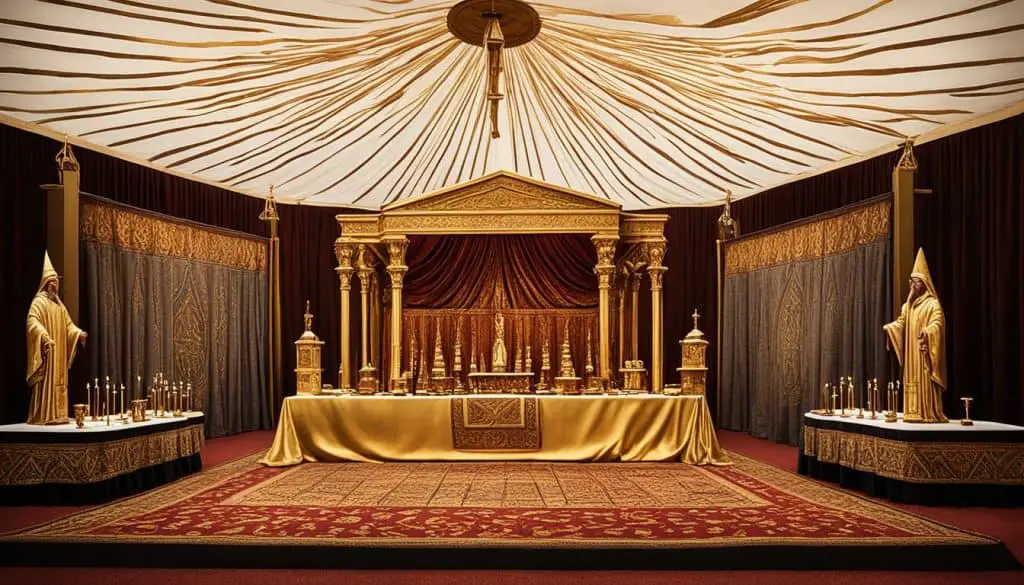
| Sacred Item | Meaning |
|---|---|
| Ark of the Covenant | Symbolized the presence of God and held the Ten Commandments |
| Table of Showbread | Represented divine provision and sustenance |
| Golden Lampstand | Symbolized divine light and presence in the tabernacle |
| Altar of Burnt Offering | Used for worship and atonement through animal sacrifices |
| Bronze Laver | Signified purification and spiritual cleansing |
| Incense Altar | Represented worship and intercession through prayers |
| Veil of the Tabernacle | Separated the Holy Place from the Most Holy Place |
Colors, Materials, and Crafts
When examining the tabernacle, it is impossible to ignore the significance of the colors, materials, and craftsmanship that went into its creation. Each aspect was carefully chosen and implemented to reflect deeper meanings and symbolism.
The symbolic colors used within the tabernacle played a crucial role in conveying spiritual concepts and representing different aspects of the divine. The vibrant hues utilized in the curtains, fabrics, and other elements were thoughtfully selected to evoke specific emotions and associations.
For instance, the color blue was prominently featured throughout the tabernacle, symbolizing the heavenly realm and divine revelation. This celestial shade served as a constant reminder of the sacredness of the space and the presence of God.
The color purple, associated with royalty and wealth, was also present in the tabernacle, signifying the majesty and sovereignty of God. Its usage in the veils and other decorative elements emphasized the grandeur and holiness of the sanctuary.
The types of wood employed in constructing the tabernacle also had symbolic significance. The use of acacia wood, known for its durability and resistance to decay, represented the eternal nature of God’s covenant with His people.
Additionally, each piece of furniture within the tabernacle was crafted with skilled hands and artistic sensibilities. The craftsmanship and artists involved in the creation of the tabernacle were highly skilled and revered for their expertise.
These skilled craftsmen were chosen by God Himself and guided by His Spirit to ensure the tabernacle reflected His glory and perfection.
Artisans such as Bezalel and Oholiab were specifically endowed with wisdom and creative abilities to carry out the intricate designs and intricate details of the tabernacle.
The craftsmanship and attention to detail exhibited in every aspect of the tabernacle’s construction were a testament to the Israelites’ devotion to God and their desire to create a physical space worthy of His presence.
Symbolism of Colors used in the Tabernacle
| Color | Symbolism |
|---|---|
| Blue | Heavenly realm, divine revelation |
| Purple | Royalty, majesty, and sovereignty of God |
| Scarlet | Redemptive sacrifice, atonement |
| White | Purity, holiness |
| Gold | Divinity, God’s glory |
Priesthood and Worship
In the context of the tabernacle, the priesthood played a vital role in facilitating the Israelites’ worship and maintaining the sacredness of the tabernacle. Let’s explore the various aspects of the priesthood and the worship practices observed within the tabernacle.
The Role of Priests
The priests held a central position in the tabernacle, serving as intermediaries between the Israelites and God. They were responsible for offering sacrifices, conducting rituals, and maintaining the sanctity of the tabernacle.
The priests acted as spiritual leaders, guiding the Israelites in their worship and providing instruction in matters of faith and obedience.
Garments Worn by Priests
The garments worn by the priests were significant, symbolizing their consecration and authority. These garments included the linen ephod, a sleeveless tunic, and the breastpiece adorned with twelve gemstones representing the twelve tribes of Israel.
The priests also wore a headdress, a sash, and linen undergarments. These garments set the priests apart and emphasized their role as mediators between God and the people.
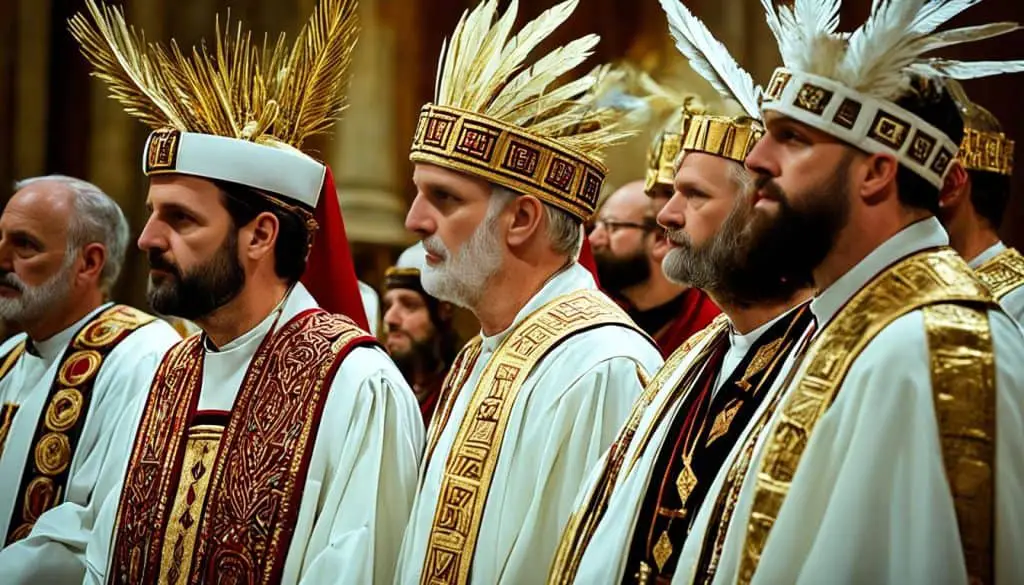
Types of Animal Sacrifices
Animal sacrifices were an integral part of the worship practices in the tabernacle. They served as a means of atonement for sins and as expressions of gratitude and dedication to God.
The types of sacrifices included burnt offerings, grain offerings, peace offerings, sin offerings, and guilt offerings. Each type of sacrifice had specific instructions and purposes, reflecting different aspects of the Israelites’ relationship with God.
Daily Life within the Tabernacle
The tabernacle was not only a place of worship but also a dwelling for the priests and a center of communal life.
The priests carried out their duties within the tabernacle complex, including offering sacrifices, tending to the sacred objects, and teaching the laws and commandments to the people.
It was a place where the Israelites could gather to seek God’s presence, receive guidance, and experience communion with Him.
Worship Practices of the Israelites
The worship practices of the Israelites encompassed various rituals, including prayers, singing of psalms, and the playing of musical instruments.
The tabernacle was a place for communal worship, where the people could offer their praises and petitions to God. It was through these worship practices that the Israelites sought to deepen their relationship with God and align their lives with His commandments.
Rituals and Symbolic Acts
Within the sacred walls of the tabernacle, a multitude of rituals and symbolic acts were performed, each carrying profound meanings and spiritual significance. These ancient practices served as a way for the Israelites to connect with the divine and express their devotion.
The rituals performed in the tabernacle encompassed various aspects of life and worship, including purification, atonement, and offering sacrifices. These acts were carefully prescribed and meticulously carried out, following specific instructions given by God to Moses.
1. Purification and Cleansing
One of the crucial rituals performed in the tabernacle was purification and cleansing. It involved the use of sacred water from the bronze laver, which symbolized the washing away of impurities and sins. This act represented spiritual renewal and the need for purification before approaching the presence of God.

2. Atonement and Sacrifice
Another significant aspect of the rituals in the tabernacle was the offering of sacrifices, particularly the sin offering and the burnt offering.
The sin offering was a symbolic act of atonement, representing the transfer of sins onto the sacrificial animal, which was then slaughtered. The burnt offering, on the other hand, symbolized complete surrender and dedication to God.
3. Communion and Fellowship
Communion and fellowship with the divine were also essential aspects of the rituals performed in the tabernacle. The table of showbread, a table within the Holy Place, held twelve loaves that represented the twelve tribes of Israel.
This act symbolized the Israelites’ constant communion and fellowship with God, acknowledging His provision and sustenance.
“The rituals performed in the tabernacle were not mere empty gestures but held deep spiritual meanings for the Israelite community.”
4. Symbolic Acts and Their Meanings
Besides the prescribed rituals, certain symbolic acts held powerful meanings within the tabernacle. For example, the lighting of the golden lampstand represented the divine presence and guidance of God, illuminating the way for the Israelites.
The burning of incense on the altar signified prayers ascending to heaven, symbolizing the Israelites’ heartfelt communication with God.
5. Spiritual Representation and Significance
Every ritual and symbolic act performed within the tabernacle held spiritual representation and significance.
They served as reminders of God’s covenant with His people, their responsibilities and commitments, and the divine relationship between the spiritual and physical realms.
Through these rituals and symbolic acts, the tabernacle was transformed into a sacred space where the Israelites could experience the presence of God and participate in the divine mysteries of worship.
The acts performed within the tabernacle were not merely physical actions but embodied spiritual truths and deeper connections with the Almighty.
Theological Significance and Insights
The tabernacle holds deep theological meanings, with each of its components symbolizing important aspects of faith and spirituality.
Understanding these meanings provides valuable insights into the significance of the tabernacle in biblical history and its connections to Christianity.
Theological Meanings of the Tabernacle’s Components
Each component of the tabernacle carries theological significance, revealing profound truths about God and His relationship with humanity. Let’s explore some of these meanings:
- The Ark of the Covenant: The ark, containing the stone tablets inscribed with the Ten Commandments, symbolizes the presence of God among His people and represents His covenant with them.
- The Table of Showbread: This table, holding twelve loaves of bread, represents the nourishment and sustenance provided by God. It signifies His provision and the fellowship enjoyed by His people.
- The Golden Lampstand: The lampstand, with its seven lamps, represents the light of God’s truth and guidance. It is a reminder of our need to walk in His light and reflect His glory to the world.
- The Altar of Burnt Offering: This altar, where sacrifices were offered, signifies the atonement and forgiveness of sins. It points to the ultimate sacrifice of Jesus Christ, who gave His life to redeem humanity.
- The Bronze Laver: The laver, used for ceremonial washing, symbolizes purification and sanctification. It represents the cleansing power of God, washing away impurities and making His people holy.
- The Incense Altar: The incense altar, where fragrant offerings were burned, signifies the prayers of God’s people rising up to Him. It reflects the importance of worship, intercession, and communion with God.
- The Veil of the Tabernacle: This veil, separating the Holy Place from the Holy of Holies, represents the barrier between God and humanity due to sin. It foreshadows the atoning work of Jesus, who tore the veil through His death, granting us access to God.
Prophetic Shadows of the Tabernacle in Christianity
The tabernacle also contains prophetic shadows that find fulfillment in Christianity. These shadows anticipate the person and work of Jesus Christ, revealing Him as the ultimate tabernacle. Here are some examples:
- High Priest: The role of the high priest, who entered the Holy of Holies once a year, symbolizes Jesus Christ as our high priest who intercedes for us before God’s throne.
- Animal Sacrifices: The sacrificial system, with its offerings for sin, points to Jesus as the perfect Lamb of God who was sacrificed to take away the sins of the world.
- The Veil: The torn veil signifies the access we now have to God through Jesus, who opened the way for us to enter into His presence.
“For Christ has entered, not into holy places made with hands, which are copies of the true things, but into heaven itself, now to appear in the presence of God on our behalf.” – Note from Hebrews 9:24 (ESV)
Connections between the Tabernacle and Jesus
The tabernacle’s components and rituals find their ultimate fulfillment in Jesus Christ. He is the embodiment of the tabernacle and its deepest meanings:
- Jesus is the true ark of the covenant, embodying both the presence of God and the fulfillment of His covenant with humanity.
- He is the bread of life, providing spiritual nourishment and fellowship as symbolized by the table of showbread.
- Jesus is the light of the world, shining God’s truth and guidance upon humanity, just as the golden lampstand illuminated the tabernacle.
- His sacrifice on the cross is the ultimate burnt offering, offering forgiveness and restoration to all who believe in Him.
- Through His blood and the work of the Holy Spirit, Jesus offers cleansing and sanctification as symbolized by the bronze laver.
- He is the eternal intercessor, offering prayers on our behalf and representing us before God, as mediated by the incense altar.
- Jesus, through His death and resurrection, has torn the veil that separated us from God, granting us direct access to His presence.
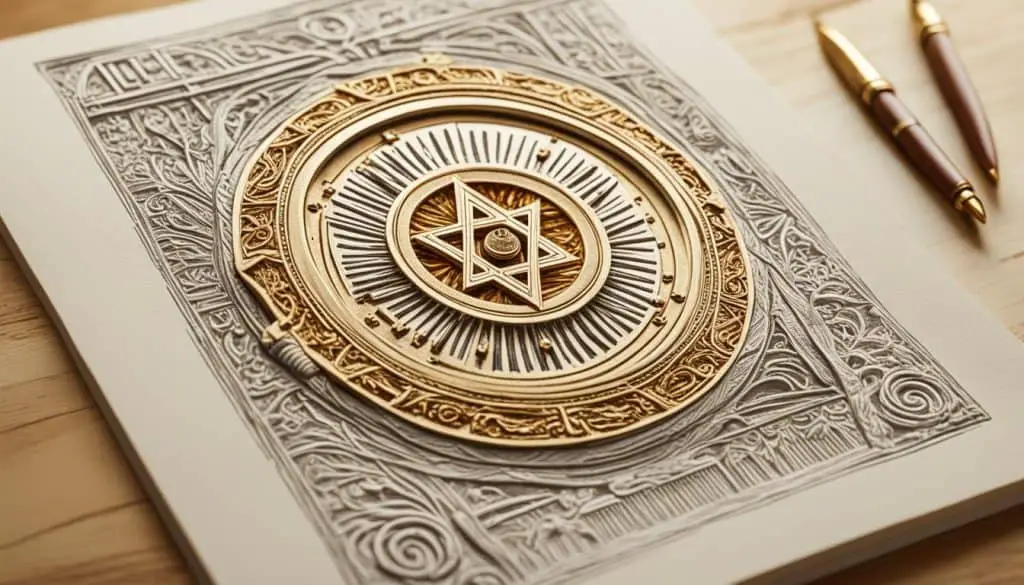
As we delve into the theological meanings of the tabernacle’s components, the prophetic shadows in Christianity, and the connections with Jesus, we gain a deeper understanding of God’s plan for redemption and His desire for a relationship with His people.
The tabernacle serves as a powerful symbol and reminder of His love, grace, and faithfulness throughout history.
Historical and Cultural Context
Understanding the historical and cultural context of the tabernacle provides essential insights into its significance and the ancient Israelite worship practices. The location and movements of the tabernacle played a crucial role in the religious and cultural life of the Israelites.
The Tabernacle’s Location and Movements
The tabernacle, also known as the Tent of Meeting, served as a portable sanctuary during the Israelites’ journey through the wilderness. According to the biblical accounts in the Book of Exodus, the tabernacle was initially located at the foot of Mount Sinai, where Moses received the Ten Commandments.
“Then a cloud covered the tent of the congregation, and the glory of the Lord filled the tabernacle.” – Exodus 40:34
After the construction of the tabernacle, it became the central place of worship for the Israelites. However, its location was not fixed. As the Israelites traveled through the wilderness, the tabernacle moved according to God’s leading, guided by a cloud by day and a pillar of fire by night.
The Tribes and Their Representations
Within the tabernacle, the twelve tribes of Israel were represented symbolically. Each tribe had its designated campsite arranged around the tabernacle, forming a larger camp. This arrangement reflected the order and unity of the Israelite community.
“All the Israelites did just as the Lord commanded Moses. Each clan and family set up camp and marched under their family banners.” – Numbers 2:34 (NLT)
Additionally, each tribe had its distinct banner or flag, displaying the emblem or symbol associated with that tribe. These symbols were based on the blessings given by Jacob to his sons, the tribal forefathers.
They were further represented through the precious stones on the high priest’s breastplate, emphasizing the unique role and identity of each tribe within the nation of Israel.
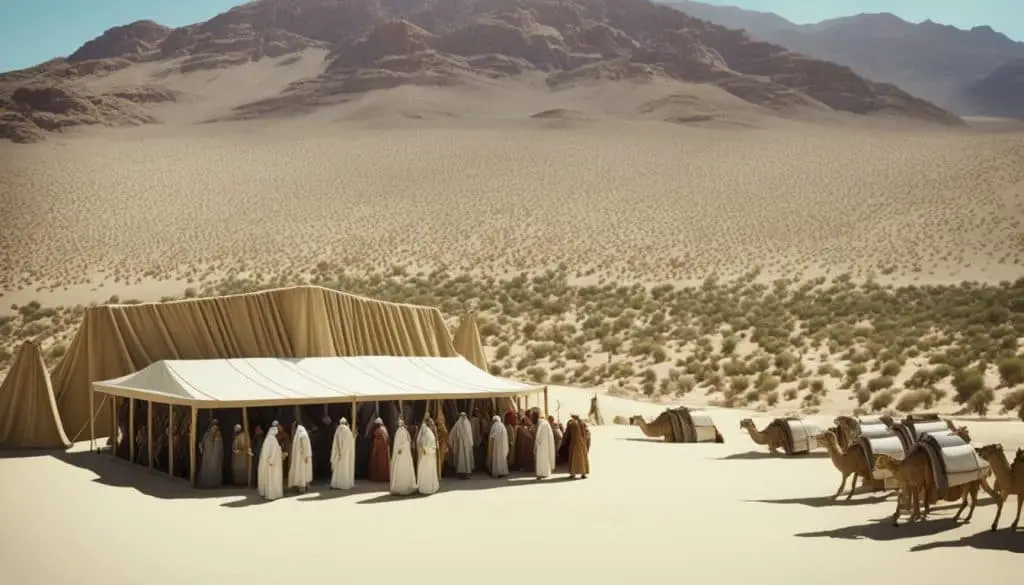
The image above visually represents the movement and positioning of the tabernacle during the Israelites’ journey through the wilderness, highlighting the tribes and their designated campsite locations.
The Tabernacle in Scripture and Tradition
References to the tabernacle can be found in the New Testament, demonstrating the lasting significance and symbolism of this sacred structure.
These references provide valuable insights into the mysteries and teachings derived from the tabernacle’s design and purpose.
In the Gospel of John, for instance, Jesus refers to Himself as the “true tabernacle” (John 2:19-21), indicating that He is the ultimate dwelling place of God among His people.
This statement highlights the tabernacle’s foreshadowing of Jesus Christ and His redemptive mission.
Furthermore, the book of Hebrews extensively explores the tabernacle and its role in the Old Testament as a precursor to Christ’s ministry.
The author expounds upon the intricate details of the tabernacle, emphasizing its relevance to understanding the heavenly realities and the supremacy of Jesus Christ as the High Priest (Hebrews 8-9).
A deeper study of these references in the New Testament unlocks profound mysteries and teachings. The tabernacle’s components and ceremonies serve as symbols that point to spiritual truths and profound theological meanings.
Through the tabernacle, we gain insights into the nature of God, the need for atonement, and the importance of worship and obedience.
“The tabernacle is a copy and shadow of the heavenly things. For when Moses was about to erect the tent, he was instructed by God, saying, ‘See that you make everything according to the pattern that was shown you on the mountain.'” – Hebrews 8:5
Exploring the References
Let us delve into some of the key references in the New Testament that shed light on the mysteries and teachings derived from the tabernacle:
- Jesus as the true tabernacle (John 2:19-21)
- The tabernacle as a foreshadowing of Christ’s sacrifice (Hebrews 9:11-14)
- The tabernacle as a symbol of God’s presence and dwelling (Hebrews 9:24)
- The tabernacle and the High Priesthood of Jesus (Hebrews 2:17, Hebrews 4:14-16)
- The tabernacle as a reminder of the need for atonement (Hebrews 9:22)
By examining these references and the rich symbolism they convey, we can deepen our understanding of biblical history, theology, and the profound truths encapsulated within the tabernacle.
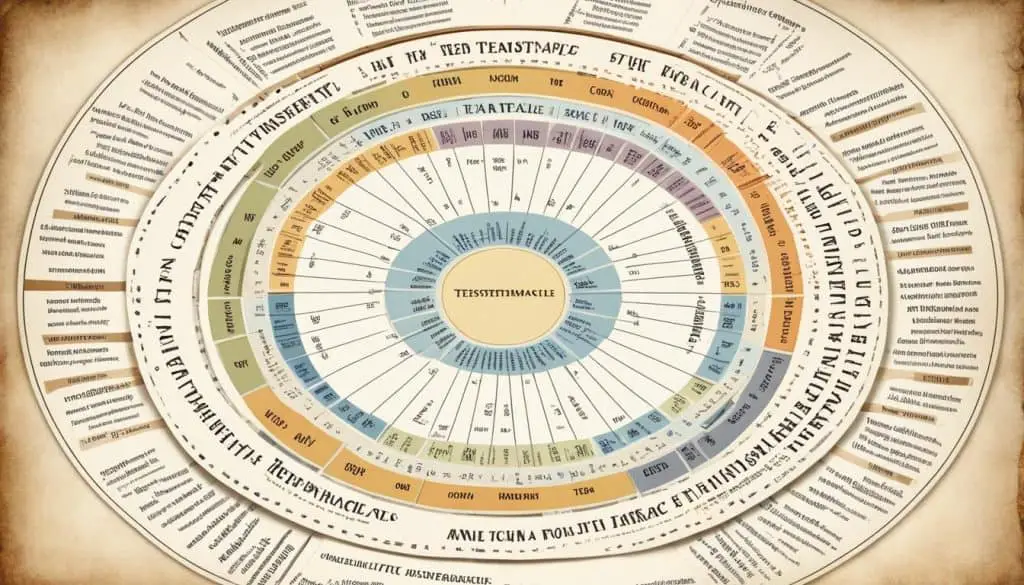
| Reference | Book | Verse |
|---|---|---|
| Jesus as the true tabernacle | John | 2:19-21 |
| Tabernacle as a foreshadowing of Christ’s sacrifice | Hebrews | 9:11-14 |
| Tabernacle as a symbol of God’s presence | Hebrews | 9:24 |
| Tabernacle and the High Priesthood of Jesus | Hebrews | 2:17, 4:14-16 |
| Tabernacle as a reminder of the need for atonement | Hebrews | 9:22 |
Miracles and Supernatural Events
Throughout history, the tabernacle has been associated with awe-inspiring miracles and extraordinary supernatural events. These remarkable occurrences serve as powerful reminders of the divine presence and intervention within the tabernacle.
One of the most well-known miracles associated with the tabernacle is the parting of the Red Sea. As the Israelites fled from the pursuing Egyptian army, Moses stretched out his hand over the sea, and by the power of God, the waters miraculously parted, allowing the Israelites to cross on dry land.
This miraculous event marked the liberation of the Israelites from slavery and highlighted the tabernacle as a symbol of God’s deliverance.
Another miracle occurred within the tabernacle itself when the Ark of the Covenant was carried by the priests during the conquest of Jericho. As the Israelites marched around the city for seven days, the walls of Jericho came tumbling down by the divine power.
This supernatural event demonstrated the strength of God’s presence within the tabernacle and His faithfulness to His people.
A miraculous event involving a tabernacle item is found in the story of Eli and Samuel. While Samuel served in the tabernacle as a young boy, he heard a voice calling his name.
Assuming it was Eli, the high priest, Samuel repeatedly went to Eli, but Eli realized that it was the voice of God. This divine encounter marked the beginning of Samuel’s prophetic ministry and showcased the tabernacle as a place where God’s voice could be heard.
“And the Lord came and stood, calling as at other times, ‘Samuel! Samuel!’ And Samuel said, ‘Speak, for your servant hears.'” – 1 Samuel 3:10
These miracles and supernatural events serve as powerful testimonies to the significance of the tabernacle as a sacred dwelling place of God. They remind us of the divine power and presence that surrounded the tabernacle, enriching our understanding of biblical history and theology.

How Did the Tabernacle Play a Role in the Lives of Bible Monarchs and Their Prophetic Encounters?
The Tabernacle held significant importance for Bible monarchs prophetic encounters. It served as a place for divine communication and spiritual guidance. The monarchs would seek the counsel of the prophets within the Tabernacle, where they would receive insight and direction for their leadership and kingdom.
Conclusion
Throughout this comprehensive guide, we have delved into the profound history of the tabernacle, exploring its significance in ancient Israelite worship and culture.
By understanding the structure, design, and key components of the tabernacle, we have gained insights into the religious practices and symbolism of the Israelites.
The tabernacle’s colors, materials, and the craftsmanship involved in its creation reveal the meticulous attention to detail in constructing a sacred space for worship.
We have also explored the role of the priesthood, the rituals and symbolic acts performed inside the tabernacle, and the theological meanings intertwined with its components.
In discussing the historical and cultural context of the tabernacle, we have uncovered its movements and the representations of the twelve tribes of Israel. References in the New Testament and the miracles associated with the tabernacle have provided further depth and perspective to its significance in biblical history.
By recapitulating these key insights, we have deepened our understanding of the tabernacle’s importance in biblical history and theology.
From its construction and sacred components to its rituals and theological significance, the tabernacle serves as a testament to the Israelites’ devotion and their rich spiritual heritage.






